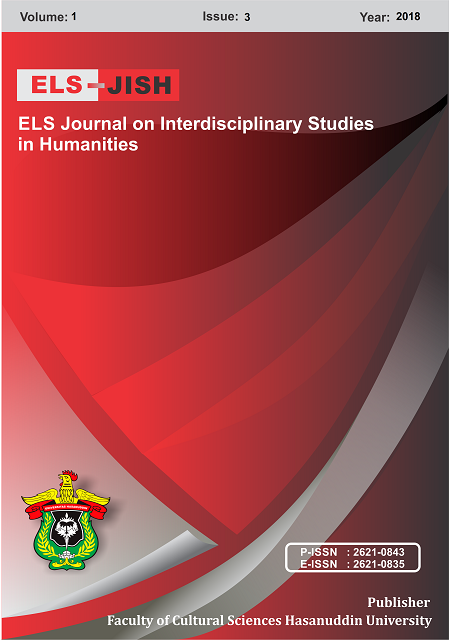Similar Articles
- Dian Fera Pratiwi, Rahmah Julianti, Sinta Dewi Anggung, Nur Ima, Nur Mutmainnah Halim, Mobile Assisted Language Learning (MALL) to Enhance Students Speaking , ELS Journal on Interdisciplinary Studies in Humanities: Vol. 7 No. 4 (2024): DECEMBER
- Sukardi Weda, Geminastiti Sakkir, Andi Elsa Fadhilah Sakti, Students' English Learning Strategies in Dealing with Merdeka Belajar Kampus Merdeka (MBKM) Curriculum in Indonesia: Perceptions and Factors , ELS Journal on Interdisciplinary Studies in Humanities: Vol. 6 No. 2 (2023): JUNE
- Ismail Ismail, Dedi Dedi, Grammar Learning Strategies Practice: An Investigation of Strategies-Based Instruction Effect on Grammatical Competence , ELS Journal on Interdisciplinary Studies in Humanities: Vol. 4 No. 3 (2021): SEPTEMBER
- Sukmawati Sukmawati, Bellona Mardhatillah Sabillah, The Effect of Learning Habits and Self - Efficacy towards Students’ English Learning Outcomes , ELS Journal on Interdisciplinary Studies in Humanities: Vol. 4 No. 4 (2021): DECEMBER
- Khadijah Maming, Ali Wira Rahman, Radiah Azizah Idris, The Influence of Motivation and Learning Style on Learning Pattern Toward Students’ Speaking Improvement , ELS Journal on Interdisciplinary Studies in Humanities: Vol. 6 No. 1 (2023): March
- La Ode Achmad Suherman, Wa Ode Riniati, Sofyan Sukwara Akfan, Munirah, Natasya Dian Utami, Fitriani, Utilizing Mobile-Assisted Language Learning (Duolingo) to Foster Metacognitive Awareness and Self-Directed Learning in Non-English Major Students , ELS Journal on Interdisciplinary Studies in Humanities: Vol. 8 No. 1 (2025): MARCH
- Daniel Semuel Warouw, Meily Ivane Esther Neman, The Use of English Language Learning Strategies in learning as Foreign Language , ELS Journal on Interdisciplinary Studies in Humanities: Vol. 7 No. 1 (2024): MARCH
- Firmansyah Firmansyah, Salmia Syarifuddin, Yetty Yetty, Susi Astiantih, Student’s Experience of New Learning System in Covid-19 Pandemic , ELS Journal on Interdisciplinary Studies in Humanities: Vol. 5 No. 4 (2022): December
- Umar Umar, Noer Jihad Saleh, Abdul Hakim Yassi, Nasmilah Nasmilah, Adult EFL Learning in Digital Era , ELS Journal on Interdisciplinary Studies in Humanities: Vol. 3 No. 3 (2020): SEPTEMBER
- Sutisno Adam, Sulmi Magfirah, Vocabulary Strategies for English Learners , ELS Journal on Interdisciplinary Studies in Humanities: Vol. 5 No. 3 (2022): September
You may also start an advanced similarity search for this article.






